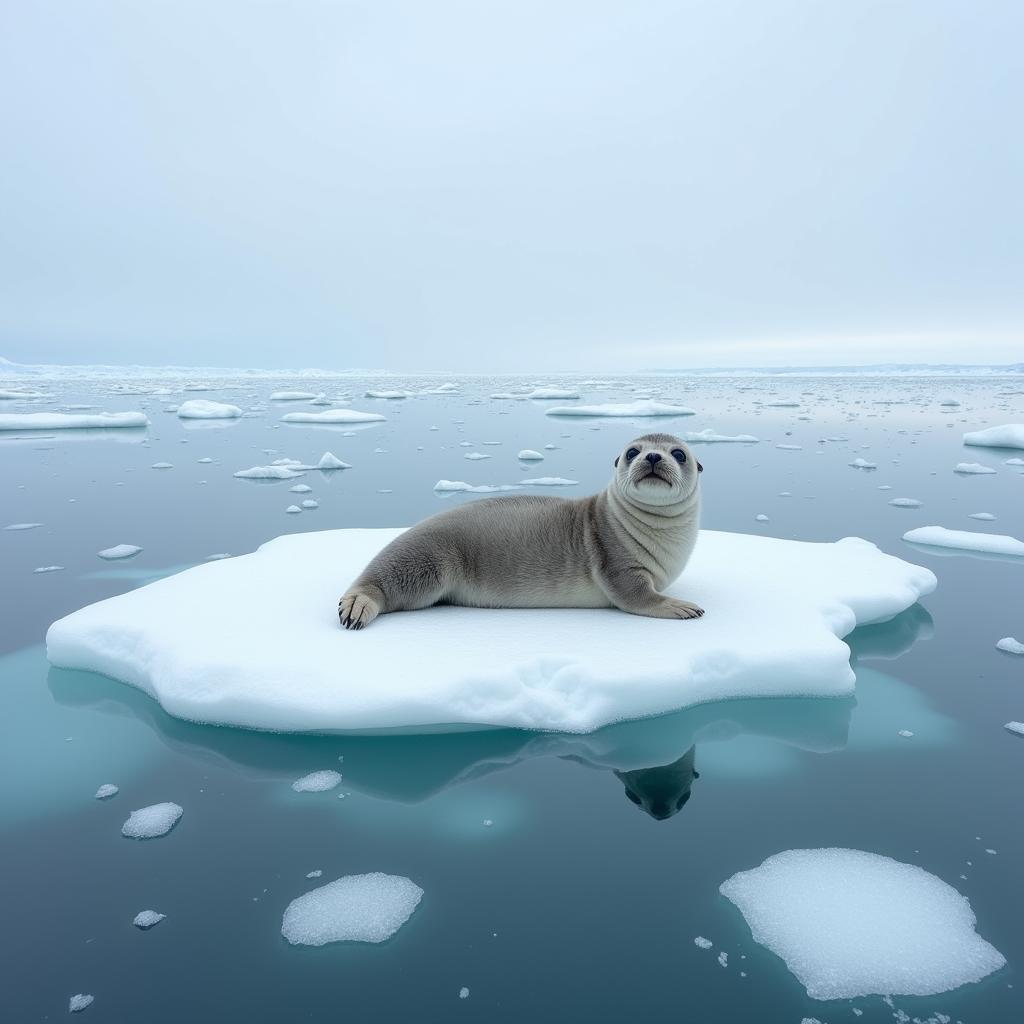The Food Chain Of A Seal is a fascinating glimpse into the delicate balance of life in the icy Arctic and Antarctic oceans. From tiny krill to apex predators, the interconnected web of life in these frigid waters relies on a complex interplay of predator and prey. Let’s explore the intricacies of this vital food chain and discover the creatures that play a crucial role in the seal’s survival.
Seals, being carnivorous marine mammals, occupy a significant position within the Arctic and Antarctic food webs. Their diet, highly adaptable to regional variations and seasonal changes, primarily consists of fish, cephalopods (like squid and octopus), and crustaceans (such as krill and shrimp). Depending on the seal species and their location, their prey can range from small fish like herring and capelin to larger species like cod and halibut. Interestingly, some seal species, like the Leopard seal, also prey on penguins and even other seals. Did you know that seals can dive to incredible depths in search of food? Some species can hold their breath for over an hour! After reading this, you may be interested in learning more about long term food storage eggs.
What Do Seals Eat? A Closer Look at Their Diet
Seals are opportunistic feeders, meaning they’ll eat whatever is most abundant and readily available. This adaptability is crucial for their survival in the challenging polar environments. Let’s explore some of the key components of a seal’s diet:
- Fish: Fish form the bulk of most seal diets. Different species of seals prefer different types of fish, influenced by factors such as fish availability, size, and nutritional value.
- Cephalopods: Squid and octopus offer a valuable source of protein and energy for seals, particularly for deep-diving species.
- Crustaceans: Krill, shrimp, and other crustaceans are important prey, especially for smaller seal species and during certain seasons. For example, during the summer months in the Antarctic, krill blooms provide a feast for crabeater seals, as their name suggests.
Predators of Seals: The Top of the Food Chain
While seals are efficient hunters, they are also preyed upon by larger, more formidable predators. This precarious balance is what keeps the food chain in check.
Orcas: The Apex Predators
Orcas, also known as killer whales, are the main predators of seals. Their intelligence, speed, and cooperative hunting tactics make them highly effective hunters.
Polar Bears: Masters of the Ice
Polar bears, particularly in Arctic regions, also pose a significant threat to seals. They often lie in wait near breathing holes in the ice, ambushing seals as they surface for air. Want to know more about food grade warehouse options?
Sharks: Oceanic Hunters
In some regions, certain shark species prey on seals, particularly younger or weaker individuals.
Human Impact on the Seal Food Chain
Human activities, such as overfishing and climate change, have a significant impact on the delicate balance of the seal food chain. Overfishing can deplete fish populations, leaving seals with less food. Climate change is affecting the sea ice, which is crucial for seal breeding and resting. Interested in arctic fish food and its role in the ecosystem?
 Climate Change Impact on Seal Habitat
Climate Change Impact on Seal Habitat
Conclusion: The Interconnected Web of Life
The food chain of a seal is a complex and dynamic system, with each species playing a vital role. Understanding these intricate relationships is essential for protecting the biodiversity of our oceans. The survival of seals depends on the health of the entire ecosystem, from the smallest krill to the largest orca. By learning more about the food chain of a seal, we can better appreciate the interconnectedness of life and the importance of conservation efforts. Need a free sample of dog food?
FAQ
- What is the main food source for seals? Fish make up the largest portion of a seal’s diet.
- What animals prey on seals? Orcas, polar bears, and some shark species are the main predators of seals.
- How does climate change affect the seal food chain? Climate change affects sea ice, which is crucial for seal breeding and resting, and can disrupt the entire food web.
- What do crabeater seals eat? Despite their name, they primarily eat krill.
- Are seals carnivores, herbivores, or omnivores? Seals are carnivores, meaning they eat meat.
- How deep can seals dive? Some seal species can dive to incredible depths, sometimes over 1,500 feet.
- How long can seals hold their breath? Some seals can hold their breath for over an hour underwater.
Situations where these FAQs are commonly asked:
- Educational settings: Teachers and students researching marine ecosystems.
- Nature documentaries: Viewers seeking further information.
- Online forums: Discussions about wildlife and conservation.
- Aquariums and zoos: Visitors wanting to learn more about the animals on display.
Further Exploration on Mina Cones Food:
- Explore our article on food grade machine oil for insights into industrial food processing.
When you need support, please contact us at Phone Number: 02437655121, Email: minacones@gmail.com Or visit our address: 3PGH+8R9, ĐT70A, thôn Trung, Bắc Từ Liêm, Hà Nội, Việt Nam. We have a 24/7 customer service team.